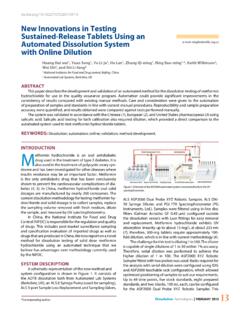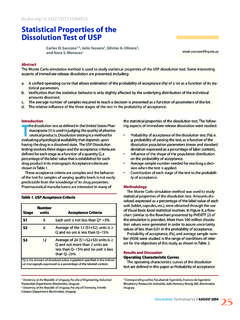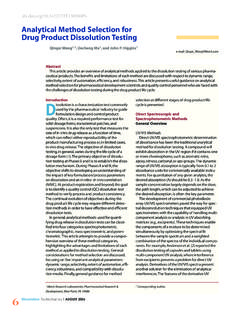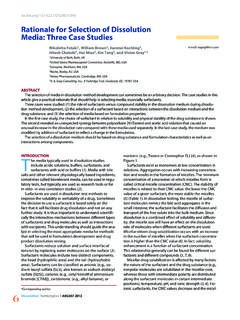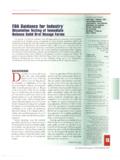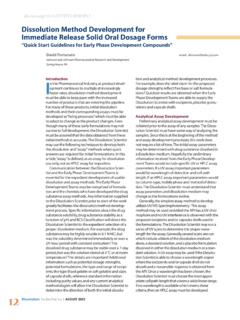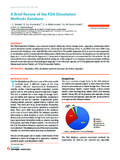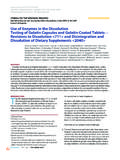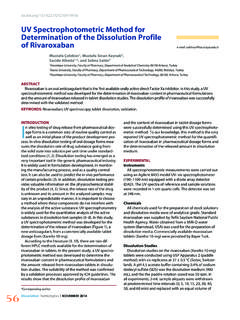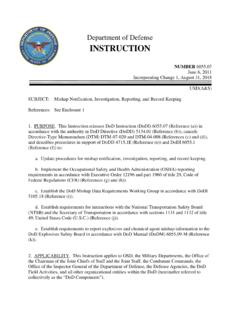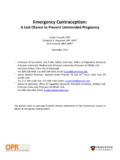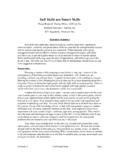Transcription of Biopharmaceutics Classification System: A …
1 Dissolution Technologies | february 201131e-mail: Classification system : A Regulatory ApproachB. Basanta Kumar Reddy1,* and A. Karunakar21 Regulatory Affair Dpt., Indchemie Health Specialities Pvt. Ltd., (Alkem Research Laboratory), , Taloja, Dist-Raigarh, Navi Mumbai Maharashtra-410208, India2 Regulatory Affair Department, IPDO, Dr. Reddy s Laboratory, Bachupally, Hyderabad, Andhra Pradesh-502325, IndiaABSTRACTThe Biopharmaceutics Classification system (BCS) is the result of continuous efforts in mathematical analysis for the elucidation of the kinetics and dynamics of the drug process in the gastrointestinal tract (GIT ) for NDA (New Drug Application) and ANDA (Abbreviated New Drug Application) filings and biowaivers.
2 This step reduces timelines in the new drug development process, both directly and indirectly, reduces unnecessary drug exposure in healthy volunteers, and increases impact for the replacement of certain bioequivalence (BE) studies with in vitro dissolution ANDA (21 CFR 314) contains data for the review and ultimate approval of a generic drug product. Generic drug applications are termed abbreviated because they generally are not required to include preclinical (animal) and clinical (human) data to establish safety and effectiveness. Instead, generic applicants must scientifically demonstrate that their products are bioequivalent ( , performs in the same manner as the innovator drug).
3 Bioequivalence studies are conducted on generic drug products in place of animal studies, clinical studies, or bioavailability studies. In vitro in vivo correlation (IVIVC) studies can be used in the development of new pharma-ceuticals to reduce the number of human studies during formulation development. The main objective of an IVIVC is to serve as a surrogate for in vivo bioavailability and to support biowaivers. IVIVCs could also be employed to establish dissolution specifications and to support and validate the use of dissolution methods. This is because the IVIVC includes in vivo relevance to in vitro dissolution specifications.
4 The introduction of the Biopharmaceutics Classification system (BCS) in 1995 was the result of continuous efforts on mathematical analysis for the elucidation of the kinetics and dynamics of the drug process in the gastrointestinal (GI) tract (1). Since the BCS was introduced, it has been used as a regulatory tool for the replacement of certain BE studies with accurate in vitro dissolution tests. This step certainly reduces timelines in the drug development process, both directly and indirectly, and reduces unnecessary drug exposure in healthy volunteers, which is the normal study population in BE AND CONCEPT OF BCSThe objectives of the BCS are (2): To improve the efficiency of the drug developmentand review process by recommending a strategy foridentifying expendable clinical bioequivalence test.
5 To recommend a class of immediate-release (IR) solidoral dosage forms for which bioequivalence may beassessed based on in vitro dissolution tests. To recommend methods for Classification accordingto dosage form dissolution along with the solubility permeability characteristics of the drug BCS, which is based on scientific principles, presents a new paradigm in bioequivalence. According to the tenets of the BCS, certain drug products can be considered for biowaivers ( , product approval based on in vitro dissolution tests rather than bioequivalence studies in human subjects).
6 At first, biowaivers were only applied to scale-up and postapproval changes (SUPAC) (3), but later the biowaiver principle was extended to the approval of new generic drug products. As a result, unnecessary human experiments can be avoided, and the cost of developing generic products can be significantly lowered (4). It provides drug designers an opportunity to manipu-late the structure or physicochemical properties of lead candidates to achieve better deliverability (5).CLASSIFICATIONSThe BCS is a scientific framework for classifying a drug substance based on its aqueous solubility and intestinal permeability (6).
7 It allows for the prediction of in vivo pharmacokinetics of oral immediate-release (IR) drug products by classifying drug compounds into four classes ( Table 1) based on their solubility related to dose and intestinal permeability in combination with the dissolution properties of the dosage form (7, 8).The interest in this Classification system stems largely from its application in early drug development and then in 313/1/ 2011 8:59:06 PM3/1/ 2011 8:59:06 Technologies | february 201132the management of product change through its life cycle.
8 In early drug development, knowledge of the class of a particular drug is an important factor influencing the decision to continue or stop its development. Therefore, an organization wishing to produce oral dosage forms will wish to limit development to molecules with high permeability. Increasingly, these considerations are incorporated from the very earliest phases, with the concept of property-based design being used in combinatorial chemistry to target production of compounds showing optimal Classification is associated with a drug dissolution and absorption model, which identifies the key param-eters controlling drug absorption as a set of dimensionless numbers (5, 7):Absorption Number (An): Defined as the ratio of the mean residence time to mea n absorption time.
9 It denotes the dimensionless dose/solubility ratio for the particular drug formulation. The dose/solubility ratio indicates whether the capacity of the GI fluid is sufficient to dissolve the entire dose = Peff tres / RDissolution Number (Dn): Defined as the ratio of mean residence time to mean dissolution = tres / tDiss Dose Number (D0): Defined as the mass divided by the product of uptake volume (250 mL) and solubility of = M0 / CsV0where M0 is the dose of drug administered, V0 is the initial gastric volume ( 250 mL), Cs is the saturation solubility, tres is the mean residence time ( 180 min), tdiss is the time required for a drug particle to dissolve, Peff is the effective permeability, and R is the radius of the intestinal IThe drugs of this class exhibit high absorption number and high dissolution number.
10 The rate-limiting step is drug dissolution, and if dissolution is very rapid, then the gastric-emptying rate becomes the rate-determining step. These compounds are well absorbed, and their absorption rate is usually higher than the excretion rate (7, 9). Examples include metoprolol, diltiazem, verapamil, and IIThe drugs of this class have a high absorption number but a low dissolution number. In vivo drug dissolution is then a rate-limiting step for absorption except at a very high dose number. The absorption for Class II drugs is usually slower than for Class I and occurs over a longer period of time.
